John Wilson, often referred to as "Old Jock" Wilson to distinguish him from his artist son, John James Wilson (1818-1875), was a significant figure in the Scottish and broader British art scene of the late 18th and early to mid-19th centuries. Born in Ayr, Ayrshire, Scotland, in 1774, and passing away in Folkestone, Kent, England, in 1855, Wilson carved out a distinguished career primarily as a painter of landscapes and, most notably, marine subjects. His work reflects the transition in British art from the more topographical traditions towards the burgeoning Romantic movement, capturing both the serene beauty and the dramatic power of nature, particularly the sea.
Early Life and Artistic Foundations
John Wilson's artistic journey began at a young age. Around the age of thirteen, in approximately 1787, he was apprenticed in Edinburgh to a house decorator named John Norrie. While decorative painting might seem a humble start, it was not an uncommon entry point into the arts during this period, providing a foundational understanding of paint application, composition, and large-scale work. More significantly for his development as a fine artist, Wilson subsequently studied under Alexander Nasmyth (1758-1840).
Nasmyth was a pivotal figure in Scottish landscape painting, often regarded as the "father of Scottish landscape painting." He had himself studied in Italy and was influenced by the classical landscapes of artists like Claude Lorrain (1600-1682) and the Dutch masters such as Jacob van Ruisdael (c. 1629-1682). Nasmyth's tutelage would have exposed Wilson to a more structured approach to landscape composition, an appreciation for naturalistic detail, and the importance of light and atmosphere. Other pupils of Nasmyth included David Wilkie (1785-1841), who would become famous for his genre scenes, and Clarkson Stanfield (1793-1867), who also excelled in marine and landscape painting, indicating the quality of instruction Wilson received.
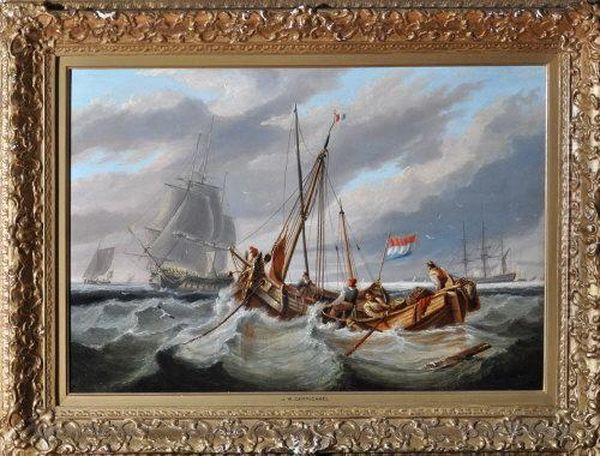
After his formative training, Wilson spent about two years residing in Montrose, a coastal town in Angus, Scotland. This period likely provided him with ample opportunity to study the sea, the coastline, and the activities of a busy port, subjects that would become central to his oeuvre. The direct observation of maritime life and the varied moods of the North Sea during this time would have been invaluable.
Relocation to London and Theatrical Scenery
Seeking broader opportunities and a larger art market, John Wilson made the pivotal decision to move to London. Initially, he found employment as a scene-painter. He worked for Astley's Amphitheatre, a popular London venue known for its equestrian displays and dramatic spectacles, and also painted scenery for other theatres. This line of work, while demanding and often ephemeral, was undertaken by many aspiring and established artists of the day, including Philippe Jacques de Loutherbourg (1740-1812), David Roberts (1796-1864), and the aforementioned Clarkson Stanfield.
Scene-painting honed several skills crucial for a landscape and marine artist: the ability to work on a large scale, to create dramatic effects of light and shadow, to depict expansive views, and to work quickly and efficiently. The theatrical demand for convincing illusions of storms, calm seas, and distant horizons would have directly fed into his easel painting practice. It also placed him within a vibrant, if sometimes overlooked, sector of the London art world.
Exhibitions and Recognition
John Wilson became a prolific and respected exhibitor at London's premier art institutions. His debut at the prestigious Royal Academy of Arts occurred in 1807, and he continued to exhibit there regularly for nearly five decades, showing a remarkable total of 76 paintings up until 1855, the year of his death. His works were also a mainstay at the British Institution for Promoting the Fine Arts in the United Kingdom (often simply called the British Institution or BI), where he exhibited an impressive 144 works between 1813 and 1854.
A significant moment of recognition came in 1825 when Wilson was awarded a premium of £100 by the British Institution for his painting, The Battle of Trafalgar. This was a substantial prize and a considerable honour, especially for a depiction of such a nationally significant event. Naval battle scenes were popular, celebrating British maritime prowess, and artists like J.M.W. Turner (1775-1851) also tackled such subjects, for instance, with his own The Battle of Trafalgar, as Seen from the Mizen Starboard Shrouds of the Victory. Wilson's success with this theme underscores his skill in handling complex compositions involving numerous ships, turbulent seas, and the dramatic atmosphere of naval warfare.
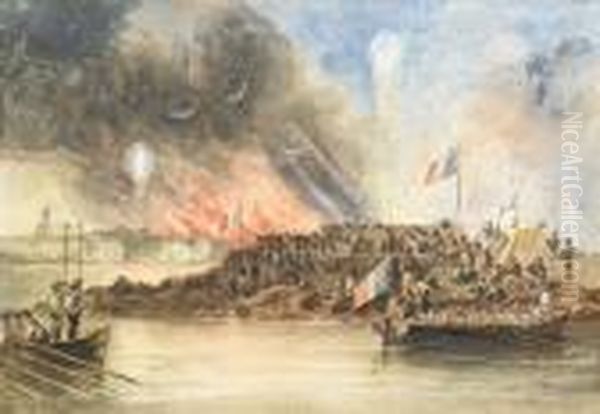
Wilson was also a founding member of the Society of British Artists (SBA), established in 1823 (later granted a Royal charter to become the Royal Society of British Artists, RBA). He served as its president in 1827. The SBA was formed by a group of artists who felt the Royal Academy was too exclusive or that its exhibition space was insufficient. Wilson's involvement highlights his standing among his peers and his commitment to promoting British art. He exhibited extensively with the SBA throughout his career.
Artistic Style, Influences, and Thematic Focus
John Wilson's art is characterized by its robust naturalism, skilled handling of light and atmosphere, and a deep understanding of maritime subjects. His style evolved from the more classical, structured landscapes influenced by Nasmyth towards a more dynamic and atmospheric approach, aligning with the broader Romantic sensibilities of the era.
His marine paintings, for which he is best known, often depict bustling harbour scenes, coastal views with fishing boats, ships navigating choppy seas, or dramatic shipwrecks. He had a particular affinity for the Dutch Golden Age marine painters, such as Willem van de Velde the Younger (1633-1707) and Ludolf Bakhuizen (1630-1708), whose influence can be seen in Wilson's attention to detail in rigging and ship construction, his depiction of cloud formations, and the lively portrayal of waves and water surfaces. Works like Dutch Vessels in a Breeze or Shipping in a Calm (titles typical of his output) reflect this Dutch influence.
While he painted grand historical marine subjects like The Battle of Trafalgar, much of his output focused on the everyday life of the coast and sea. His landscapes, often of English scenery or views inspired by trips to the "near Continent" (likely Holland and the northern French coast), demonstrate a similar keen observation of nature. He was adept at capturing the specific character of a location, whether it was the tranquil waters of the Thames or the more rugged coastlines of Britain.
Compared to his contemporary J.M.W. Turner, Wilson's work was generally less overtly sublime or experimental in its abstraction of light and colour. He remained more grounded in a faithful representation of the visible world, though imbued with a strong sense of atmosphere and often a quiet romanticism. His contemporary John Constable (1776-1837), while primarily a landscape painter, shared with Wilson a dedication to the direct study of nature and the capturing of transient effects of weather and light, though Constable's focus was more on the English countryside.

Other marine painters active during Wilson's career included Augustus Wall Callcott (1779-1844), known for his coastal scenes and landscapes, George Chambers Sr. (1803-1840), a talented marine artist from a working-class background, and William Collins (1788-1847), who often painted coastal genre scenes. Wilson's work holds its own within this strong tradition of British marine painting.
Representative Works
While a comprehensive list of all his works is extensive, some key pieces and typical subjects help illustrate his artistic concerns:
The Battle of Trafalgar (exhibited BI, 1825): This award-winning painting was a significant achievement, showcasing his ability to handle large-scale, complex historical marine subjects with accuracy and dramatic flair. It would have required meticulous research into the ships involved and the events of the battle.
The Bombardment of Sveaborg (also known as The Attack on Sweaborg): A depiction of a naval action during the Crimean War (though the main bombardment was in August 1855, the year of his death, he may have depicted earlier related events or worked from sketches/reports). A version of this is held by the National Maritime Museum, Greenwich, London. This demonstrates his continued engagement with contemporary naval events.
Coastal Scenes with Fishing Boats: A recurring theme, these works allowed Wilson to explore the interplay of light on water, the forms of different vessels, and the daily life of fishing communities. Examples might include titles like Fishermen on a Beach, Unloading the Catch, or Boats in a Harbour.
Dutch-Inspired Marine Views: Reflecting his admiration for 17th-century Dutch masters, these paintings often feature Dutch-style vessels (e.g., smacks, galliots) in estuaries or calm seas, with meticulous attention to rigging and atmospheric skies. Titles like A Dutch Smack Lying To or Shipping off the Dutch Coast are indicative.
Views on the Thames: The River Thames was a popular subject for many artists, including Turner and Canaletto (1697-1768) before him. Wilson would have depicted its bustling traffic, its varied banks, and its atmospheric conditions.
Landscapes of England and Scotland: While renowned for his marine art, he also produced pure landscapes, likely influenced by his training with Nasmyth and his observation of the British countryside.
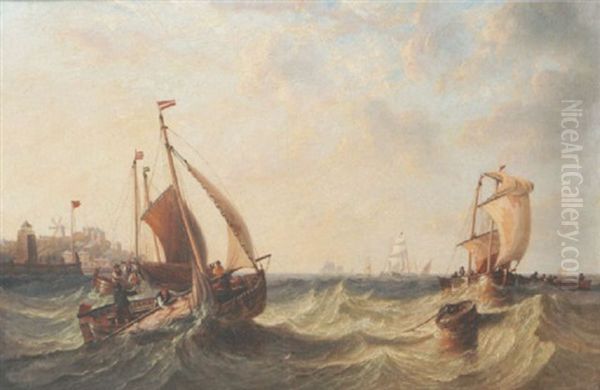
His works are characterized by a confident, often fluid brushstroke, a good sense of colour harmony, and an ability to convey the movement of water and the vastness of the sky. He often paid close attention to the human element within his scenes, whether sailors on a ship or figures on a quayside, adding life and narrative interest.
The Broader Artistic Context: Romanticism and the Rise of Marine Painting
John Wilson worked during a period of immense dynamism in British art. The late 18th and early 19th centuries saw the rise of Romanticism, which emphasized emotion, individualism, and the awe-inspiring power of nature (the sublime). While Wilson may not have been a radical Romantic in the vein of Turner or William Blake (1757-1827), his work certainly partook of the increased interest in landscape and seascape as vehicles for expressive content, moving beyond mere topographical record.
Marine painting, in particular, flourished in Britain during this era. The nation's identity was inextricably linked to its naval power and maritime trade. The Napoleonic Wars (1803-1815) further heightened public interest in naval affairs, creating a demand for depictions of sea battles, ship portraits, and coastal views. Artists like Nicholas Pocock (1740-1821) and Thomas Luny (1759-1837) specialized in accurate depictions of naval engagements and shipping. Wilson built upon this tradition, infusing it with a greater sense of atmosphere and painterly quality.
The establishment of institutions like the British Institution and the Society of British Artists provided more venues for artists to exhibit and sell their work, catering to a growing middle-class clientele interested in acquiring art for their homes. Landscape and marine paintings, being less tied to classical or religious narratives, found particular favour with this new audience.
Contemporaries and Artistic Circle
Beyond his teachers and the major figures already mentioned, John Wilson was part of a large and active community of artists in London. His long exhibiting career at the Royal Academy and the British Institution, coupled with his role in the Society of British Artists, meant he would have known, and been known by, many of his contemporaries.
These would have included landscape painters like John Glover (1767-1849), who later emigrated to Australia, and Francis Danby (1793-1861), known for his imaginative and apocalyptic landscapes. Portraitists such as Sir Thomas Lawrence (1769-1830), who was President of the Royal Academy for part of Wilson's career, and historical painters like William Etty (1787-1849), would have been prominent figures in the same exhibition spaces.
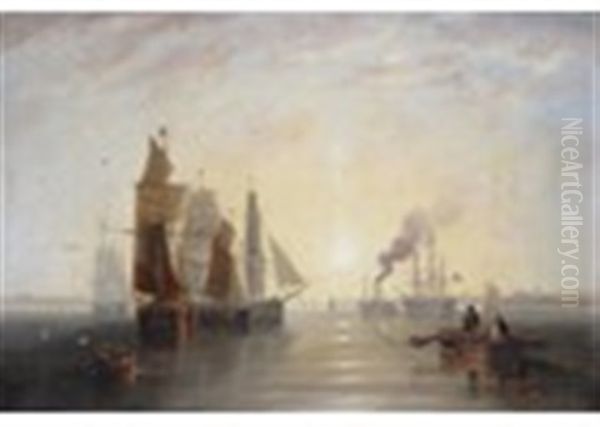
His son, John James Wilson (1818-1875), followed in his father's footsteps as a marine and landscape painter, often exhibiting similar subjects. This continuation of a family artistic tradition was not uncommon. The influence of "Old Jock" can also be seen in the work of artists like George Cole (1810-1883), who is noted to have been inspired by Wilson's landscapes around 1839-1840.
Legacy and Collections
John Wilson's legacy lies in his contribution to the rich tradition of British marine and landscape painting. He was a skilled and prolific artist who captured the maritime spirit of his age with accuracy and artistic sensitivity. His works were popular during his lifetime and continue to be appreciated for their craftsmanship and evocative portrayal of the sea and coast.
His paintings can be found in numerous public and private collections. Key institutions holding his work include:
The National Maritime Museum, Greenwich, London: As mentioned, they hold works like The Bombardment of Sveaborg.
The Victoria and Albert Museum, London: Often has works by prominent British painters of this period.
Regional UK Galleries: Many municipal galleries throughout the United Kingdom, particularly those with maritime connections or strong collections of British art, are likely to have examples of his work. The Caird Art Gallery in Dundee, for instance, has a significant collection of Scottish art and may hold his works. The reference to works being exhibited in East Ayrshire Council building to avoid inheritance tax and then placed in the Caird Art Gallery suggests a Scottish provenance for some pieces.
Government Art Collection, UK.
His success in winning the British Institution prize for The Battle of Trafalgar and his long, consistent exhibition record at major venues attest to the esteem in which he was held. While perhaps not as revolutionary as Turner or Constable, John Wilson was a highly competent and respected artist who played a significant role in popularizing marine and landscape subjects.
Addressing Potential Confusions: Other Notable John Wilsons
It is worth noting that the name "John Wilson" is relatively common, and several other individuals named John Wilson achieved prominence in different fields, sometimes leading to confusion.
The painter John Wilson (1774-1855) discussed here should not be confused with:
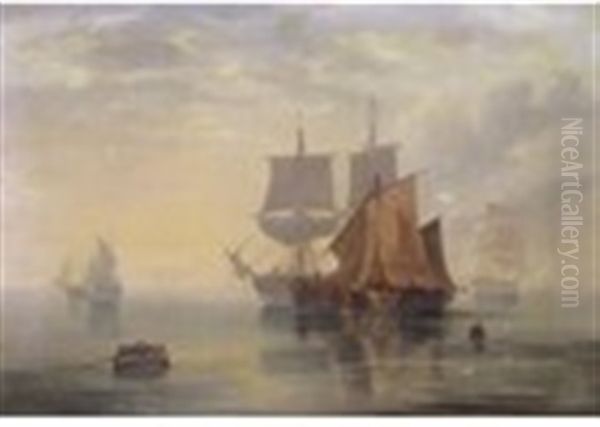
John Wilson (1922-2015), the American artist: This later John Wilson was an African American painter and sculptor known for his powerful works addressing themes of social justice, racial equality, and the Black experience. His notable pieces include drawings and prints like Lynching and the monumental bronze bust of Martin Luther King Jr. for the U.S. Capitol. His style and thematic concerns are entirely distinct from the 19th-century Scottish marine painter.
John Wilson (born 1968), the British conductor and musicologist: This contemporary John Wilson is celebrated for his work with the John Wilson Orchestra, particularly his reconstructions and performances of Hollywood film musical scores and British light music.
John Wilson (1720–1789), the British botanist: This earlier John Wilson was the author of A Synopsis of the British Plants, in Mr. Ray's Method (1744). An anecdote sometimes circulates about a John Wilson who, in his passion for botany, considered selling his cow to buy Robert Morison's Plantarum Historiae Universalis Oxoniensis. This story pertains to this botanist, John Wilson of Kendal, not the painter.
Clarifying these distinctions is important for an accurate art historical understanding of John Wilson, the Scottish landscape and marine painter.
Conclusion
John Wilson (1774-1855) stands as a noteworthy figure in 19th-century British art. From his early training in Scotland to his long and successful career in London, he developed a distinctive style, particularly in marine painting, that combined careful observation with an appreciation for atmospheric effects. His numerous exhibits at the Royal Academy and the British Institution, his award for The Battle of Trafalgar, and his role in the Society of British Artists all speak to a career of substance and peer recognition. He captured the essence of Britain's maritime world, from the drama of naval battles to the everyday activities of its coasts and harbours, leaving behind a body of work that continues to engage viewers with its skill and evocative power. His contribution to the tradition of marine art, influenced by Dutch masters yet firmly rooted in the British context of his time, ensures his place in the annals of art history.